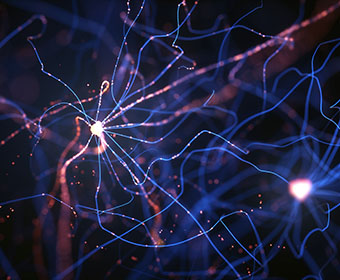
(May 8, 2019) – Dysfunctions and malformations in the scaffold of a cell are thought to contribute to heart muscle weakness, neurodegenerative disease and even deafness. Now biophysics research at The University of Texas at San Antonio (UTSA) has taken a closer look at a cell’s cytoskeleton and found a new purpose: It aids in energy transfer and information processing in neurons.
Marcelo Marucho, an associate professor in the UTSA Department of Physics and Astronomy, studies, in particular, the cytoskeleton’s actin filaments and microtubules for the past 4 years. He works to track how the transfer of energy along these structures impacts cellular function.
The research proposes that structural changes in the filaments (mutations) and alteration in the biological fluids break down the equilibrium and competition between the molecular mechanisms that dominate the bundling and transmission properties of cytoskeleton filaments in normal conditions. This, in turn, yields impaired assembly and defective electric signal propagation along these filaments leading to cellular pathology.
Age and hereditary factors are known to contribute to the development of diseases, however Marucho’s research provides insight into how the cytoskeleton’s electrical properties contribute to the degradation of a cell.
“There is evidence that filaments conduct electricity, like an electrical cord,” said Marucho, who combines both biology and physics to understand what he calls the bionanowire—a cell’s electrical cable. “The filaments, F-Actin and microtubules, are able to propagate electrical impulses inside neurons. This property is something that scientists generally haven’t considered.”
The cell’s cytoskeleton, or filaments, are responsible for a cell’s shape. They also organize cellular parts and impact a cell’s movement and division. But Marucho believes that cells cytoskeleton filaments are also capable of conducting electrical energy.
The UTSA researcher developed multi-scale models with patch clamp and light scattering experiments to determine how electricity spreads and how it affects the mechanical properties of filaments. These preliminary results will help him better understand the normal conditions that allow the cell’s bionanowire to develop.
“We also want to elucidate how the pH solution, salts including amount and type, generate the correct healthy formation of cytoskeleton structures,” said Marucho. “Biological fluid is a necessary medium to mediate the interactions between cytoskeleton filaments.”
In total, Dr. Marucho was awarded $1.5 million in research funding over four years from the National Institutes of Health (NIH) to continue his work on Actin filaments and to look more in-depth at microtubules.
This NIH grant is part of a banner year for research dollars at UTSA. In FY 2018 alone, UTSA’s total research and development expenditures reached $69.7 million.
Learn more about the Marucho Lab.
Explore a degree in the UTSA Department of Physics and Astronomy.
Celebrate UTSA’s 50th Anniversary and share social media posts about the 50th using the hashtag #UTSA50.
Connect with UTSA online at Facebook, Twitter, YouTube, Instagram and LinkedIn.
UTSA Today is produced by University Communications and Marketing, the official news source of The University of Texas at San Antonio. Send your feedback to news@utsa.edu. Keep up-to-date on UTSA news by visiting UTSA Today. Connect with UTSA online at Facebook, Twitter, Youtube and Instagram.
Join the PEACE Center and Wellbeing Services for Denim Day, a day of learning about the importance of consent and why we wear denim on the last Wednesday of the month each April during Sexual Assault Awareness Month. Stop by our Denim Day display to take a photo in front of our Denim Wall, spin the "Is It Consent?" Wheel, and get a Concha or goodie.
Student Union Window Lounge, Main CampusLearn to use Zotero®, a citation manager that can help you store and organize citations you find during your research. Zotero can generate bibliographies in various styles, insert in-text citations and allow you to share sources with collaborators.
Virtual EventThis event will acknowledge graduating seniors from the McNair Scholars program at UTSA before inducting the new cohort of scholars into the program.
North Paseo Building (NPB 5.140), Main CampusAt this memorable celebration, UTSA graduates will be introduced one-by-one to cross the stage and accept their doctoral degrees.
Arts Building Recital Hall, Main CampusRoadrunner Walk is an event for graduating students to have a memorable walk on campus to celebrate an important milestone and their achievements. Graduates will walk along the Paseo while being celebrated by the UTSA community, friends, and family members.
Student Union Paseo, Main CampusCelebrate the accomplishments of College of Education and Human Development, College for Health, Community and Policy, College of Sciences and University College.
Alamodome, 100 Montana St.Celebrate the accomplishments of Alvarez College of Business, College of Liberal and Fine Arts and Klesse College of Engineering and Integrated Design.
Alamodome, 100 Montana St.The University of Texas at San Antonio is dedicated to the advancement of knowledge through research and discovery, teaching and learning, community engagement and public service. As an institution of access and excellence, UTSA embraces multicultural traditions and serves as a center for intellectual and creative resources as well as a catalyst for socioeconomic development and the commercialization of intellectual property - for Texas, the nation and the world.
To be a premier public research university, providing access to educational excellence and preparing citizen leaders for the global environment.
We encourage an environment of dialogue and discovery, where integrity, excellence, inclusiveness, respect, collaboration and innovation are fostered.
UTSA is a proud Hispanic Serving Institution (HSI) as designated by the U.S. Department of Education .
The University of Texas at San Antonio, a Hispanic Serving Institution situated in a global city that has been a crossroads of peoples and cultures for centuries, values diversity and inclusion in all aspects of university life. As an institution expressly founded to advance the education of Mexican Americans and other underserved communities, our university is committed to promoting access for all. UTSA, a premier public research university, fosters academic excellence through a community of dialogue, discovery and innovation that embraces the uniqueness of each voice.